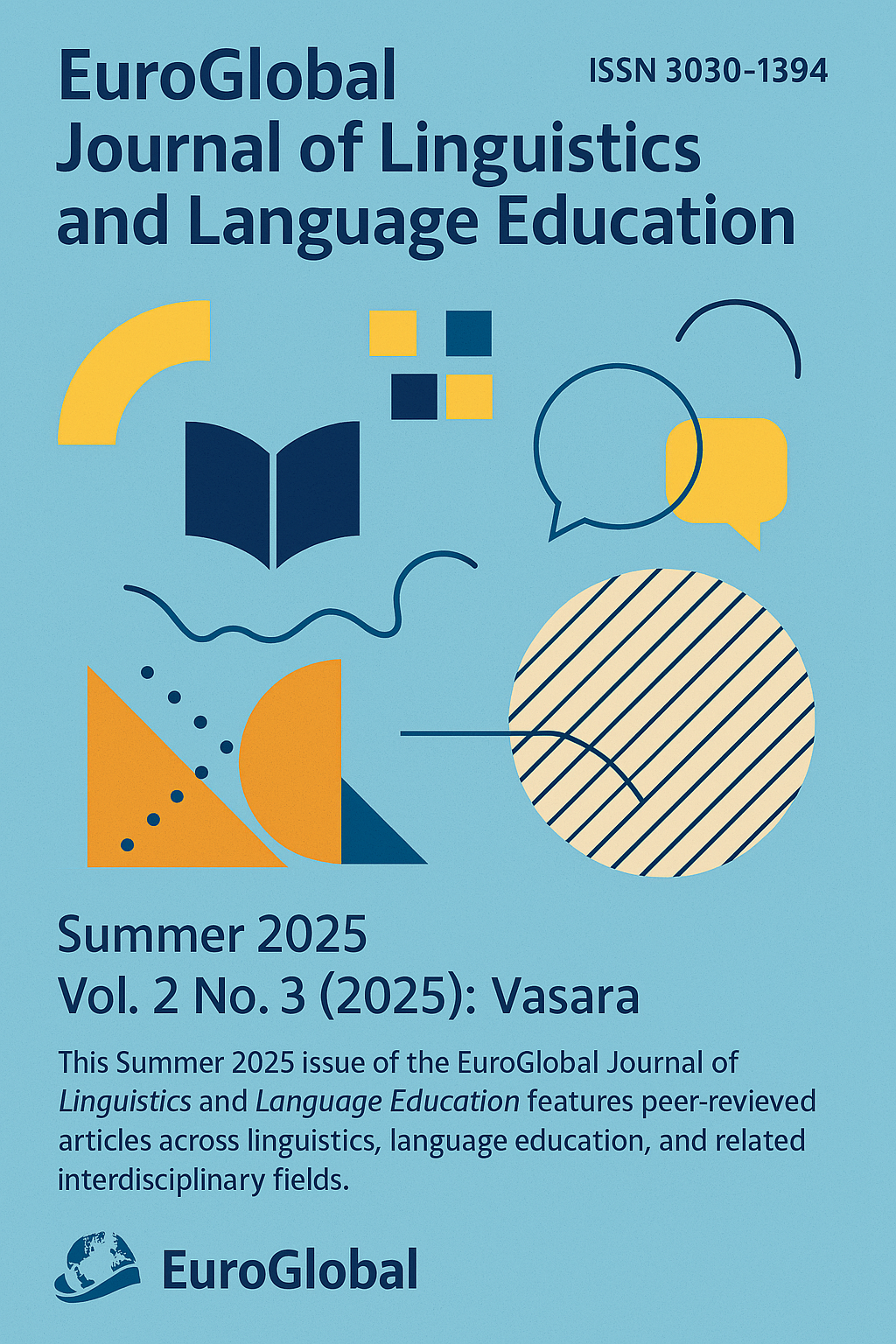The Linguistic Expression of Emotion: A Cross-Cultural Analysis
DOI:
https://doi.org/10.69760/egjlle.2500195Keywords:
Linguistic Relativity, Emotional Expression, Cross-Cultural PragmaticsAbstract
This study examines the relationship between language and emotion through a cross-cultural lens, exploring how different linguistic structures influence emotional perception and expression. Grounded in the linguistic relativity hypothesis, it investigates whether the way emotions are categorized, verbalized, and understood differs across languages and cultural contexts. Through a theoretical and qualitative analysis of linguistic resources, multilingual corpora, and cross-cultural pragmatic frameworks, this study highlights significant differences in emotional articulation. Findings suggest that while basic emotions are universally recognized, their linguistic encoding varies; some languages provide finer distinctions between emotional states, while others rely on contextual rather than explicit expression. Western individualistic cultures tend to favor direct emotional articulation, whereas collectivist cultures often depend on indirect or pragmatic cues. Additionally, bilingual speakers report experiencing different emotional intensities depending on the language of expression, reinforcing the emotional resonance hypothesis. These insights have profound implications for cross-cultural communication, translation studies, and the cognitive processing of emotions. The study calls for further exploration of underrepresented languages and multilingual emotional articulation to gain a deeper understanding of the intricate relationship between language and emotion.
References
Alisoy, H. (2023). Understanding Inversion and Detachment in English. Web of Semantic: Universal Journal on Innovative Education, 2(12), 45-52.
Alisoy, H. (2025). A Structural and Semantic Classification of Phraseological Units in English. Global Spectrum of Research and Humanities , 2(3), 12-24. https://doi.org/10.69760/gsrh.0203025002
Alisoy, H. (2025). Stylistic Analysis of Donald Trump’s Inaugural Speech: Lexical, Syntactic, and Rhetorical Features. Acta Globalis Humanitatis Et Linguarum, 2(3), 9-19. https://doi.org/10.69760/aghel.0250020002
Barrett, L. F., Lindquist, K. A., & Gendron, M. (2007). Language as context for the perception of emotion. Trends in cognitive sciences, 11(8), 327-332.
Cutting, A. L., & Dunn, J. (1999). Theory of mind, emotion understanding, language, and family background: Individual differences and interrelations. Child development, 70(4), 853-865.
De Gelder, B. (2006). Towards the neurobiology of emotional body language. Nature reviews neuroscience, 7(3), 242-249.
Dewaele, J. M. (2008). The emotional weight of I love you in multilinguals’ languages. Journal of Pragmatics, 40(10), 1753-1780.
Galandarova, A. (2025). War, Colonization, and Language Evolution: Tracing Linguistic Shifts in Global History. Acta Globalis Humanitatis Et Linguarum, 2(1), 199-206. https://doi.org/10.69760/aghel.02500125
Hajiyeva, B. (2025). Translating Idioms and Slang: Problems, Strategies, and Cultural Implications. Acta Globalis Humanitatis Et Linguarum, 2(2), 284-293. https://doi.org/10.69760/aghel.025002123
Hudson, T., Brown, J. D., & Detmer, E. (1995). Developing prototypic measures of cross-cultural pragmatics (Vol. 7). Natl Foreign Lg Resource Ctr.
Kuperman, V., Estes, Z., Brysbaert, M., & Warriner, A. B. (2014). Emotion and language: valence and arousal affect word recognition. Journal of Experimental Psychology: General, 143(3), 1065.
Lindquist, K. A., Barrett, L. F., Bliss-Moreau, E., & Russell, J. A. (2006). Language and the perception of emotion. Emotion, 6(1), 125.
Lindquist, K. A., MacCormack, J. K., & Shablack, H. (2015). The role of language in emotion: Predictions from psychological constructionism. Frontiers in psychology, 6, 444.
Lucy, J. A. (1997). Linguistic relativity. Annual review of anthropology, 26(1), 291-312.
MacIntyre, P., & Gregersen, T. (2012). Affect: The role of language anxiety and other emotions in language learning. In Psychology for language learning: Insights from research, theory and practice (pp. 103-118). London: Palgrave Macmillan UK.
Matsumoto, D. (1993). Ethnic differences in affect intensity, emotion judgments, display rule attitudes, and self-reported emotional expression in an American sample. Motivation and emotion, 17(2), 107-123.
Mesquita, B., & Walker, R. (2003). Cultural differences in emotions: A context for interpreting emotional experiences. Behaviour research and therapy, 41(7), 777-793.
Pavlenko, A. (2008). Emotion and emotion-laden words in the bilingual lexicon. Bilingualism: Language and cognition, 11(2), 147-164.
Pennebaker, J. W., & Francis, M. E. (1996). Cognitive, emotional, and language processes in disclosure. Cognition & emotion, 10(6), 601-626.
Ridgeway, D., Waters, E., & Kuczaj, S. A. (1985). Acquisition of emotion-descriptive language: Receptive and productive vocabulary norms for ages 18 months to 6 years. Developmental Psychology, 21(5), 901.
Sadiqzade, Z. (2024). The Use of the Detective Genre in 19th-Century English Prose. Acta Globalis Humanitatis Et Linguarum, 1(1), 56-66. https://doi.org/10.69760/aghel.01024065
Sadiqzade, Z. (2025). From Neologisms to Idioms: Tracing Literary Innovation in the Evolution of the English Lexicon. Porta Universorum, 1(1), 13-18. https://doi.org/10.69760/k2g75h54
Sadiqzade, Z. (2025). Idiomatic Expressions and Their Impact on Lexical Competence. Journal of Azerbaijan Language and Education Studies, 2(1), 26-33. https://doi.org/10.69760/jales.2025001002
Slobin, D. I. (2003). Language and thought online: Cognitive consequences of linguistic relativity. Language in mind: Advances in the study of language and thought, 157192, 157-192.
Slobin, D. I. (2011). Verbalized events: A dynamic approach to linguistic relativity and determinism. In Evidence for linguistic relativity (pp. 107-138). John Benjamins Publishing Company.
Thomas, J. (1983). Cross-cultural pragmatic failure. Applied linguistics, 4(2), 91-112.
Wiebe, J., Wilson, T., & Cardie, C. (2005). Annotating expressions of opinions and emotions in language. Language resources and evaluation, 39, 165-210.
Wierzbicka, A. (2003). Cross-cultural pragmatics: The semantics of human interaction. Mouton de Gruyter.
Wilce, J. M. (2009). Language and emotion (No. 25). Cambridge University Press.
Zamanova, U. (2024). The Linguistic Melting Pot: Understanding Borrowed Words in Modern English. Acta Globalis Humanitatis Et Linguarum, 1(2), 20-33. https://doi.org/10.69760/aghel.01024062
Downloads
Published
Issue
Section
License
Copyright (c) 2025 EuroGlobal Journal of Linguistics and Language Education

This work is licensed under a Creative Commons Attribution-NonCommercial-NoDerivatives 4.0 International License.





